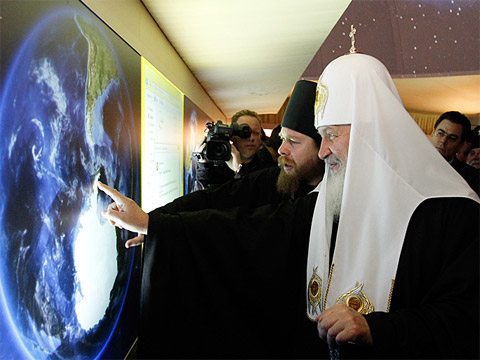 |
| Patriarch Kirill and Archimandrite Tikhon (Shevkunov) locate a Russian Orthodox Church on Antarctica. Photo: Patriarchia.ru |
At the beginning of the exhibition is the Tikhvin miracle-working icon of the Mother of God, placed in a special shrine for veneration by the faithful. After the Bolshevik revolution, this icon was located in Chicago, and returned in 2004 to the newly restored Tikhvin monastery in Russia.
The exhibition program will include various conferences, round table discussions, presentations, and master classes relating to the exhibition’s theme. After its close in Moscow on November 7, 2011, the exhibition will travel to other major cities in Russia and abroad from the years 2012–2014. Admission in Moscow is free.
Also unprecedented for this annual event is the level of technology used. From the multi-media display telling the story of Russia’s New Martyrs and the years of persecution against the church, to the dynamically transforming church dome over the touch-screen monitor room, where you can pull up diocesan information from a rotating globe, to a back-lit photography exhibition—a visitor of any age will not be bored.
There is also a collection of painting and sculpture, much of it in the classic Russian historical style, which captures the heart of Orthodox Russia. Other museum exhibits of vestry art and metal craft are also on display.
His Holiness Patriarch Kirill of Moscow and All Russia presided over the exhibition’s opening on Friday. Also present were the Vice Chairman of the Government of the Russian Federation, Alexander Zhukov, exhibition organizer Sergei Trofimov, responsible secretary of the Patriarchal Cultural Council, Archimandrite Tikhon (Shevkunov), and many other hierarchs and clergy. A group of children from the Ukraine greeted the Patriarch with a song.
After venerating the Tikhvin icon, His Holiness the Patriarch gave the opening speech, the original text of which (in Russian) can be found on the Patriarchate’s website:
“Today, the day of National Unity, we are opening our traditional exhibition, “Orthodox Russia”. But this year our exhibition is special: twenty years have passed since the rebirth of our Church, and over these twenty years, over the breadth of Holy Russia has occurred what has never occurred before in the history of mankind. Not one country, not one civilization, not one religious group, not one Church has experienced what we have experienced—a grandiose renaissance of Orthodoxy. It is thousands of restored churches, hundreds of monasteries; it is institutes of learning, hospitals, hospices, social centers, schools for adults and children; it is work with the armed forces and in prisons; is what truly only the people could do. Therefore we say that over these twenty years, not only has the Russian Church been reborn in its monuments, but our people have been reborn. Because churches are not built or restored if there is no need for them, if there is no powerful movement from the grass roots, if these churches are not filled with people. No one would invest their financial resources in something that is not needed.
“We have invested money, but money is not the point. We have invested our energy, our intellectual strength, our fervent feeling and faith in the rebirth of Rus’. Today’s exhibition is not an excuse for triumphalism—although one cannot help but celebrate what has been accomplished, because it is a unique event in world history. Today’s exhibition should help all of us to understand what the Russian Church is, and move forward from that foundation to make our faith the motivating force capable of working miracles, as it did at the beginning of seventeenth century, when Russia was miraculously freed from her enemies who had subjugated the capital city and taken over the Kremlin.
“God works miracles when people are ready to receive those miracles. Readiness to receive a miracle is always nothing other than the people’s participation in the working of that miracle. Then, at the beginning of the seventeenth century, victory required enormous effort, the rebirth of national self-awareness, eagerness for self-sacrificing labor and the labor itself—and people did this, uniting fervent prayer to their courageous and heroic deeds.
“It is no accident that the Day of National Unity falls on the feast of the Kazan icon of the Mother of God, which was carried [as a banner] during the uprising led by Minin and Pozharsky. I believe that is also how we won the Great Patriotic War [WWII], when human effort and podvig were joined with fervent faith and prayer by all the people. I believe that in this and in no other way shall we attain new victories in peaceful life, overcoming the hardships that stand in our way, building peace, prosperity, and a happy life for our Fatherland. In saying this, I address my words to all of historical Holy Rus’, believing that by the people’s prayers, by their labors, the Lord will help us accomplish what we yearn for—to build a spiritual life that is strong, wholesome, healthy, and materially flourishing.”
The Patriarch thanked all the organizers and representatives of the federal and municipal government who made the exhibition possible, and expressed his conviction that it will be a significant event in the spiritual, cultural, and community life of Russia.
Pravoslavie.ru (Russian) has opened a website dedicated to “Orthodox Russia”, which will continue to operate even after the exhibition closes in Moscow.
